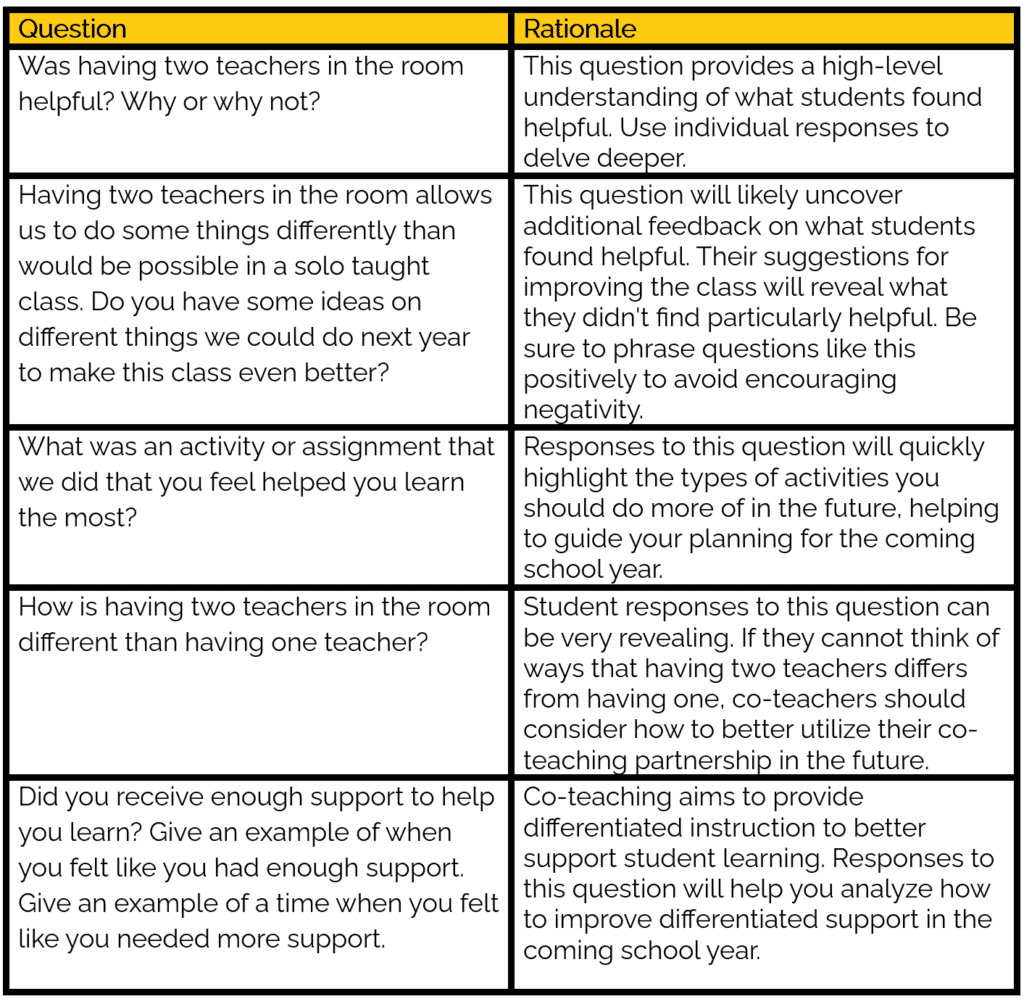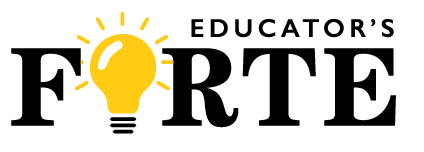As the school year ends, it’s a great time to support teachers in reflecting on their co-teaching experience and setting goals for the coming year. One effective way to initiate this reflection is by asking students for their thoughts.
Follow this process:
Step 1: Elicit Support
Step 2: Prepare Feedback Questions
Step 3: Gather Student Feedback
Step 4: Reflect on Student Feedback
Step 5: Set Growth Goals
Step 6: Develop an Action Plan
This article will guide you through each step of this process.
Step 1: Elicit Support
Enlist support before beginning this process. Ask your instructional coach, lead teacher, or any instructional leader to participate. Explain that your purpose is to improve your co-teaching partnership for the coming school year by gathering and analyzing student feedback, then using that feedback to set appropriate growth goals and develop an action plan. This support person can play a key role in some steps of this process and will provide unbiased perspectives when needed.
Step 2: Prepare Feeback Questions
Start by choosing key areas where student feedback will be most helpful for reflection and goal setting in the coming year. Carefully consider the rationale for each question, focusing on the information you seek to uncover and the types of responses each question is likely to elicit.
We recommend using no more than five questions for this reflective activity. Design broad questions that encourage thoughtful responses, and phrase them positively to avoid prompting negative or plaintive answers.
You may involve the instructional coach or lead teacher in crafting specific questions tailored to your unique needs.
Below are five suggested feedback questions along with the rationale for each.

Step 3: Gather Feedback
There are several effective ways to gather feedback from students, depending on how much time you have and the level of detail you’d like to have in responses. Here we offer three suggestions. You may choose one or a combination of these ideas.




Step 4: Reflect on Student Feedback
Invite the instructional coach to join you and your co-teaching partner for guided reflection. Including the coach or another instructional support person will offer a non-biased viewpoint on student comments and help you see student comments from a different perspective. This is particularly helpful when the instructional coach has pre-existing knowledge of your class.
Review all the comments and select the most important areas to analyze more closely. Use the 5 Whys approach to dig deeper and determine the core reasons for the feedback students provided. This approach is a simple way to delve into an area of concern and determine a root cause (or causes) for the issue. For complex problems, the analysis may need to go further, but the 5 Whys is a great starting point and can often reveal the true issues.
The framework for the 5 Whys:
- State the problem or concern.
- Ask the first why and throw out multiple possible responses. Ensure responses are grounded in fact, not emotion. Only consider factual responses for further analysis.
- Ask why at least four more times, focusing only on factual responses. Each time you ask why again, you get further clarification on the issue, helping you devise more focused goals for growth.

Step 5: Set Growth Goals
After thoroughly analyzing the most important student feedback, choose one or two key root issues to address as growth goals for the coming school year. Set these goals as SMART goals, then plan a strategy for addressing each one. Remember that SMART goals are:
Specific
Measurable
Achievable
Relevant
Time Bound
For the example we used for the 5 Whys analysis, an appropriate SMART goal for Ms. Smith and Mr. Adams might be:
During the 24-25 school year, Mr. Adams will improve his content knowledge in Algebra. He will lead instruction on at least a portion of two lessons per week. Ms. Smith will work with Mr. Adams ahead of time to ensure he fully understands the math concepts and lessons, and the two of them will plan those specific lessons together at least one week in advance. Progress will be reviewed with the instructional coach each quarter.
Specific: The goal clearly states that Mr. Adams will improve his content knowledge in Algebra and will lead instruction on portions of two lessons per week. It also specifies that Ms. Smith will assist Mr. Adams in understanding the concepts and planning lessons.
Measurable: The goal includes measurable components such as leading instruction on two lessons per week and quarterly reviews with the instructional coach.
Achievable: The goal is realistic and attainable, with Mr. Adams receiving support from Ms. Smith and planning lessons together in advance.
Relevant: The goal is relevant to Mr. Adams’ professional development in improving his Algebra content knowledge so that he can more effectively lead instruction.
Time bound: The goal has a clear time frame, covering the entire 24-25 school year, with specific weekly goals and quarterly checkpoints.
Step 6: Develop an Action Plan
A goal without a plan is just a wish.
After carefully crafting one or two SMART goals with your co-teaching partner, devise a detailed plan of action. Your plan should be as specific as your goal, ensuring it is achievable and time bound.
Include preparatory work like professional development opportunities, completing book studies together or independently, or working with mentors or instructional coaches. Develop processes to follow during the year, request key supports from school administration critical to accomplishing your goals or seek support from other experts within the district.
Put your plan in writing to avoid ambiguity. Most importantly, ensure you and your co-teaching partner align with the plan and are both ready to do what it takes to be successful.
Following is a sample action plan for Ms. Smith and Mr. Adams:
Preparation and Professional Development:
- Summer 2024:
- Adams will spend time during the summer studying the grade-level algebra text, seeking resources online to refresh his knowledge.
- Adams and Ms. Smith will complete a book study focusing on instructional models for co-teaching to help them better plan co-taught lessons.
Weekly Planning:
- Ongoing:
- Adams and Ms. Smith will use a collaborative digital planning tool to map out lessons at least two weeks in advance, specifically identifying which lessons Mr. Adams needs to be prepared to lead instruction for and identifying the instructional model that will be used.
- Adams and Ms. Smith will use their before-school time to review key math concepts and lessons once per week.
- Adams and Ms. Smith, with the support of administration, will receive class coverage for half of one school day per month to work on more detailed plans.
Instruction and Implementation:
- Weekly:
- Adams will lead instruction on portions of two Algebra lessons each week, applying the concepts and strategies discussed during the planning meetings.
- Smith will provide feedback after the lessons to support Mr. Adams’ growth and development.
Monitoring and Assessment:
- Bi-weekly:
- Conduct brief check-ins to discuss progress and any challenges encountered during instruction.
- Adjust the planning and instructional strategies as needed based on these check-ins.
Quarterly Review:
- End of each quarter:
- Meet with the instructional coach to review progress towards the goal.
- Analyze student performance data to assess the effectiveness of Mr. Adams’ instruction.
- Set new targets and adjust the action plan as needed based on feedback from the instructional coach and student outcomes.
Support and Resources:
- Ongoing:
- Ensure that Mr. Adams has access to necessary resources, including textbooks, instructional materials, and digital tools.
- Seek additional support from school administration or district experts as needed to address specific challenges or areas for growth.
By following this action plan, Mr. Adams will systematically improve his Algebra content knowledge and instructional effectiveness throughout the 24-25 school year, effectively improving the co-teaching partnership.
Worth the Effort
As the school year ends, seize this opportunity to reflect on your co-teaching experience and set meaningful goals for the coming year. By following this structured feedback and reflection process, you can harness valuable insights from your students to drive your professional growth. Setting SMART goals and developing a detailed action plan ensures that your efforts are targeted and effective. Commit to this process, work collaboratively with your co-teaching partner, and engage your instructional support team. By doing so, you will strengthen your co-teaching partnership, enhance your instructional strategies, and create a more impactful learning environment for your students. Embrace this journey of continuous improvement and look forward to a rewarding and successful school year ahead!
Download a PDF of this blog here.
